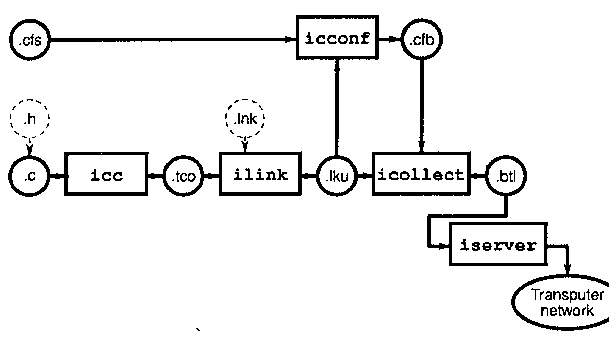REKLAB manual (SERVO CONTROL - ak)
Program development using the toolset
The following has been taken directly from the manual for the transputer, please refer to it for further information. READ THE ENTIRE FILE SOME IMPORTANT INFORMATION ARE LOCATED AT THE END OF THE SECTION.
The ANSI C toolset is a cross-development system for transputers. Creation of exacutable code for a transputer or transputer network takes several stages involving the use of specific tools at each stage. Program development is supported by tools which provide failities for debugging, creating object code libraries, automating the program build, and for importing code from earlier toolsets.

The main stages in developing a program and the tools to use at each stage are listed below:
1. Write the source (file_name.c):
Source code can be written using any ACCII editor available on the system. Code can be divided between any number of source files. Source code must conform to the ANSI standard. Source code must conform to the ANSI standard. Source code syntax can be checked prior to compilation by invoking the compilier with the check option.
2. Compile the source
Each source file is compiled using the ANSI C compilier icc to produce one or more compiled object files in TCOFF format. Eache file must be compiled for the same transputer type or for a transputer class covering several compatibles taypes. Commonly used object code can be combined into libraries using ilibr.
3. Link the compiled units
The compiled source files are linked together using ilink. This generates a single file called a linked unit in which all external refernces are resolved. the linking operation also links in the library modules required by the program, which are selected by transputer type from the compiled library code. Compiled source files can be generated by any TCOFF compatible compiler.
4. Configure the program (file_name.cfs)
For multitranputer programs a configuration description must be constructed in order to assign linked units to specifiec nodes on the transputer network and link them be channel variable. The description is processed by the configurer tool icconf to produce a cofiguration data file.
5. Generate a runnable file
The configuration data file generated by icconf is read by the code collector icollect which generates a single executable file for a tranputer network. The same tool is used to generate bootable files for single transputer programs directly from linked units.
6. Load and run the program
The executable or bootable
file is loaded and run on the transputer network down a host link using iserver.
Once loaded the code begins to execute immediately. The server tool also starts
yp and maintains the environment that supports the program's communication with
the host.
All the procedures described above are taken care of by the Makefile (see next section). However, two files must be supplied by the user. These are the "c" code for the controller (file_name.c) which should be placed in the "control/source/" directory, and the configuration description file (file_name.cfs) which should be placed in the "control/cfs/" directory.
Right now, the control system uses "c_law.lku" which has been compiled from "c_law.c" and the configuration description file "contol.cfs". A good idea would be to use these files as examples when creating new control systems for the actuators. As far as I know, there should be only one thing to modify in the the configuration description file. Change:
use "./lku/c_law.lku" for C_Law;
to
use "./lku/whatever_your_c _code_name_is.lku" for C_Law;
That should be all. Please, read the next page for details concerning the use of the Makefile.
Next
Last modified: Wed Sept 25 11:34 AM 1996